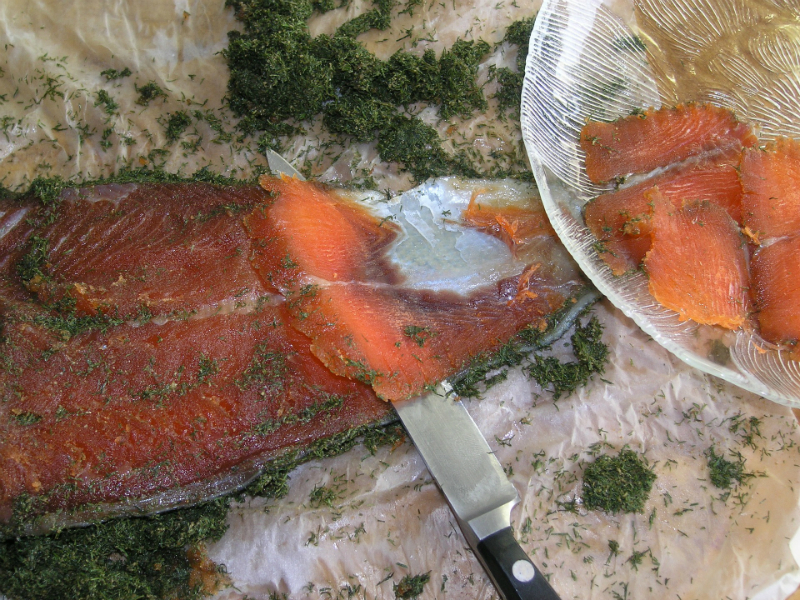I am a convert to Judaism who was born and raised in Norway, before moving to the United States. About a year ago, I had a strange food-writing experience when I worked with an editor at a Maine food magazine. She was a Jewish woman who was interested in what I had to say about a gravlaks recipe she had printed in an earlier issue, since I had a native Norwegian take on it. I suggested some possible alternative ways to prepare the dish. I wrote the essay and included my recipe and tips.
The story of my Jewish journey was also part of the essay, as it is central to my culinary tapestry, just as my Norwegian heritage is. But before the piece went to print, the editor asked me to remove any references to Judaism. “It’s our policy to not involve religion,” she noted. I was stunned. I decided that if I could not talk about my Jewish identity as freely as I could my Norwegian one, I was not interested in the assignment. Food is, after all, one of the central elements of culture, and if my Jewish culture is not kosher to talk about, then count me out.
My childhood in Norway was teeming with fish in all imaginable varieties. My parents and their friends would often catch and prepare their own cod, salmon, crabs and mussels at various times of the year. I ate five varieties of herring by the time I was three. But then, at the age of 20, I met a Jewish man and fell in love, and at 23, I underwent an Orthodox conversion. Suddenly, all the shellfish traditions of my birth family became off-limits, because I went all in and wanted to be both kosher and shomer Shabbat. Thankfully, herring and lox were a big part of my adopted culinary tradition, too.
At my oldest son’s bar mitzvah, I prepared those five varieties of herring (with tomato sauce; wine sauce; beets, apples and onions; curry sauce; and cream sauce) and cured enough gravlaks in our synagogue kitchen to feed more than 250 people. When guests are coming to my house for a meal on Shabbat or yom tov, I often make gravlaks, because it needs to be made ahead of time, which takes some pressure off on the day it’s served.
Since I have a penchant for languages and etymologies, the word “gravlaks” calls for a brief note. The suffix “-laks” is the Norwegian word for salmon; while the prefix “grav” means, “to dig,” or “grave.” In the olden days before refrigeration, the fresh salmon was cured and preserved by being placed in a deep hole in the ground and covered by dirt.
This would help ensure a more stable temperature and, together with the generous amounts of salt, would help preserve the food. Salted and dried cod, lamb ribs, pork and reindeer were all traditionally cured with salt. Furthermore, I travel in circles where the word “lox” is so deeply ingrained by the iconic New York food culture of bagels and lox (as in smoked salmon) that I have spent the last 30 years of my life in the U.S. insisting that “no, it’s not like lox.” So, as the viking Jewess I am, I must insist: it’s gravlaks.
I am definitely a self-professed foodie, and today, more than 28 years after becoming Jewish, my culinary explorations include many Israeli staples and delicacies. But there’s still nothing like combining my Norwegian heritage with my adopted Jewish culture when serving home-made gravlaks.
Nina’s Gravlaks Recipe
o 2.5 kg (5 lb) salmon, divided into two equal fillets with skin on, to be sandwiched for curing period
o 150 ml (10 tbsp) sugar
o 150 ml (10 tbsp) kosher salt
o 75 ml (5 tbsp) peppercorns, slightly cracked with a mortar and pestle
o Fresh dill, to taste
o Brandy or whisky
Mix salt, sugar and pepper in a bowl.
Evenly spread plenty of torn up fresh dill on the flesh side of one of the fillets. Pour spice mixture over it and put second fillet on top, flesh side down.
Wrap salmon tightly in heavy-duty aluminum foil, place in a pan, cookie sheet or platter with a lip (to contain liquid that will seep out during curing) and put something heavy on top of it (I use a brick, but anything works, such as cans of food). Place in the fridge and set a reminder to flip and drain every 12 hours.
Each time you turn the package over, drain off the salty, gooey liquid (brine) that has seeped out into the pan. I also hold the package over the sink to let it drain as much as possible, before returning it to the fridge, flipped over and with the weight back on top. Draining the brine is important, otherwise the gravlaks can become too salty.
After 48 hours, unwrap the fillets and wipe them clean with a wet paper towel. If the spice mixture has caked on during the curing process, run the fillets under cold water and dry with paper towel.
After the fillets have been cleaned, pour some of your favourite brandy or whisky into the palm of your hand and rub it over the fillets. This cuts some of the salty taste and adds an understated and round finish to the fish. For looks, I sprinkle finely chopped dill on the fillets, before slicing them thinly on an angle and arranging them on a platter.
Gravlaks is best served with plenty of lemon wedges and traditional mustard dill sauce (recipe to follow).
Mustard Dill Sauce
o 30 ml (2 tbsp) Dijon mustard
o 15 ml (1 tbsp) sugar
o 30 ml (2 tbsp) white vinegar
o 125 ml (1/2 cup) extra virgin olive oil
o salt
o white pepper
o 30-60 ml (2-4 tbsp) fresh dill, finely chopped
Mix mustard, sugar and vinegar in a small bowl.
While whisking, add olive oil in a fine and constant stream.
Season with salt and white pepper and stir in fresh dill.







